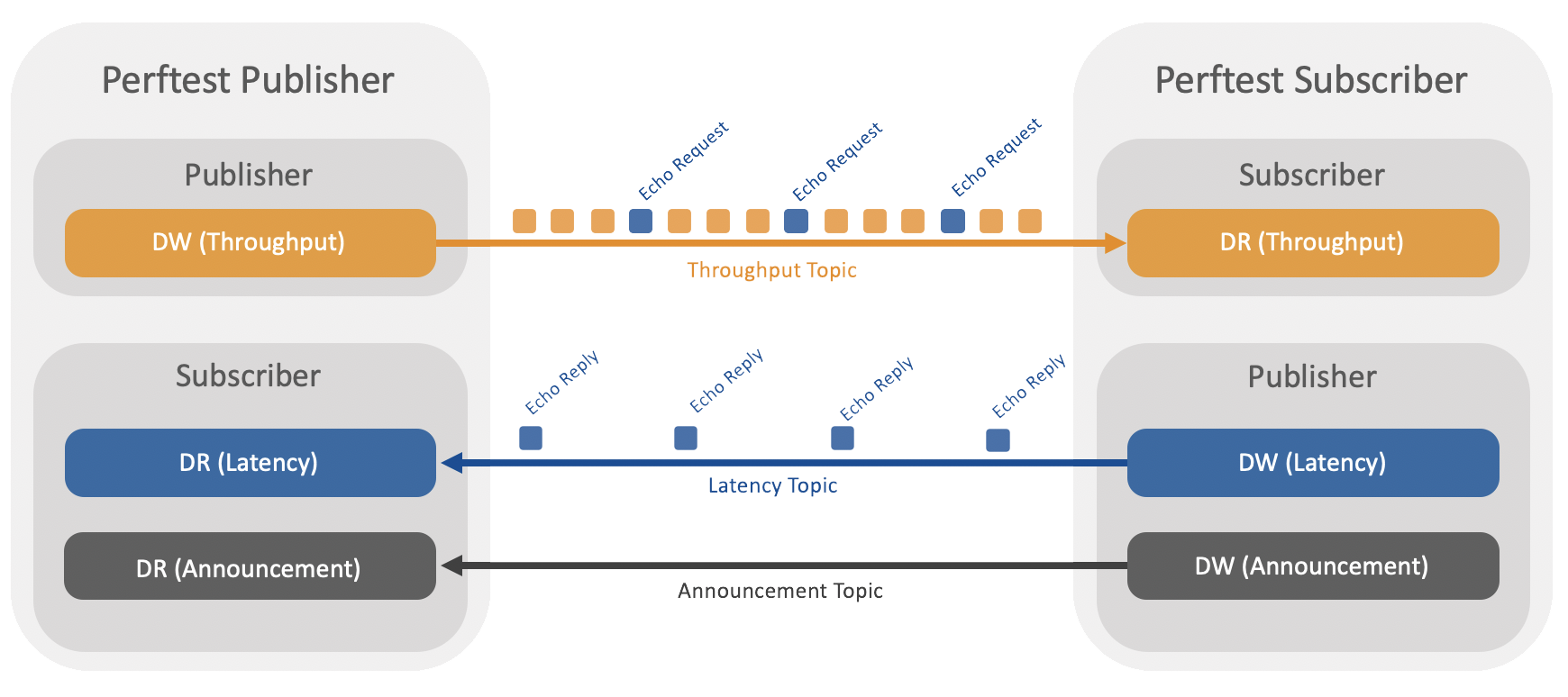RTI Perftest
Overview¶
RTI Perftest is a command line tool intended to measure the minimum latency, maximum throughput and loaded latency in a very configurable set of scenarios. It can help you answer questions such as:
For a given publishing configuration (e.g., queue size, batching settings), sample size, and subscribing configuration (e.g., queue size, Listener vs. WaitSet), what is the throughput of my network?
When my network is heavily loaded, what latency can I expect?
For a given configuration, what is the best-case latency with no other traffic on the network?
How does it work¶
The publishing side of the test writes data as fast as it can. Every few samples (configured through the command line), it sends a special sample requesting an echo from the subscribing side. It uses this ping -> pong exchange to measure the round-trip time latency (RTT) and then the one-way latency (RTT/2).
The publisher prints the latency test results while the subscriber prints the throughput results.

RTI Perftest allows 2 operational modes: Throughput Test and Latency Test.
Learn more in the Introduction section.
Features¶
RTI Perftest features include:
Supports RTI Connext DDS Professional and RTI Connext DDS Micro.
Suppots multiple platform including Windows, Linux, Mac, VxWorks or Android.
Supports multiple test setups - Multicast, One-to-many communication (Pub -> Sub), Latency test, Throughput test, Latency vs Throughput test.
Supports using raw transports (UDPv4 Sockets and Shared Memory segments).
Suports benchmarking Connext Pro and Micro features such as Flat Data and Zero Copy.
Getting Started¶
This is an example of how you may give instructions on setting up your project locally. To get a local copy up and running follow these simple example steps.
Download¶
RTI Perftest bundle is provided in 3 different ways:
Clone and compile from the official Github repository:
git clone https://github.com/rticommunity/rtiperftest.git
2. Download and compile from: https://github.com/rticommunity/rtiperftest.
3. Download the executables for popular platforms from the binaries section in the RTI Perftest release page here.
To learn more about the supported platforms and installation, please refer to the Download section.
Requisites¶
If you need to compile RTI Perftest these are the 2 main requisites. This is not needed if you downloaded the executables already compiled, you can skip this section.
RTI Connext DDS Professional or RTI Connext DDS Micro should be installed in the system where the build.sh script is going to run. The Target libraries for the platform to be generated should also be installed.
The $NDDSHOME environment variable should be set correctly. Alternatively, $NDDSHOME can be passed directly to the build.sh script by using the --nddshome <PATH> command-line option.
If you intend to compile and test using RTI Security Plugins, you will need to link against the OpenSSL libraries for your architecture.
Learn more in the Compilation section.
Compile¶
For Linux, MacOS, QNX, VxWorks, Lynx, and Android, RTI Perftest makes use of a script in the top-level directory named build.sh.
On Windows it uses an equivalent script named build.bat. To build using these scripts, simply invoke them with the
command-line parameters desired.
For example, for a given architecture (x64Darwin15clang7.0) for C++ (traditional and modern) and Java, the command would be:
./build.sh --platform x64Darwin15clang7.0
If you want to build the C# API implementation:
./build.sh --cs-build
Learn more about compilation for other platforms and examples in the Compilation section.
Usage¶
The following are examples of how to run the performance test for two use cases:
The tests below print final results only; if you want to see intermediate values, remove the
-noprintargument from the command line.If you are running on two unequal machines---i.e., one machine is faster (has better processors) than another---you will see better performance by running the Publisher on the slower machine.
Example 1: 1-to-1, Unicast, Best Latency as a Function of Message Size¶
Publisher:
bin/<arch>/release/perftest_cpp -pub -noPrint -nic <ipaddr> -dataLen <length> -latencyTest -executionTime 100
Subscriber:
bin/<arch>/release/perftest_cpp -sub -noPrint -nic <ipaddr> -domain <ID> -multicast
Modify -dataLen <bytes> ` to see latencies for different data sizes. Set `-executionTime <seconds> to be >=100 for statistically better results.
Example 2: 1-to-1, Multicast, Maximum Throughput as a Function of Message Size (with Batching)¶
Publisher:
bin/<arch>/release/perftest_cpp -pub -noPrint -nic <ipaddr> -dataLen <length> -batchSize <bytes> -multicast -executionTime 100
Subscriber:
bin/<arch>/release/perftest_cpp -sub -noprint -nic <ipaddr> -multicast
To achieve maximum throughput, start by setting See -batchSize <bytes> to 8192, then increase the size to see if you get better throughput.
Note: Batching will not be enabled if the data length is larger than 1/2 the batch size.
Explore the documentation for more information.